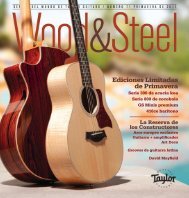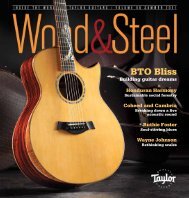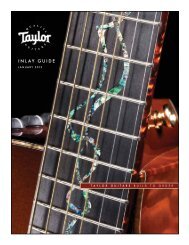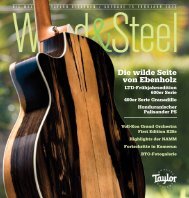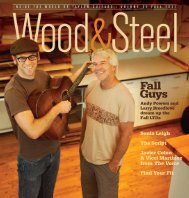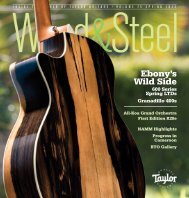HUMIDITY'S GREATEST HITS - Taylor Guitars
HUMIDITY'S GREATEST HITS - Taylor Guitars
HUMIDITY'S GREATEST HITS - Taylor Guitars
Create successful ePaper yourself
Turn your PDF publications into a flip-book with our unique Google optimized e-Paper software.
T A Y L O R T E C H S H E E T<br />
HUMIDITY’S <strong>GREATEST</strong> <strong>HITS</strong><br />
A S P U B L I S H E D I N W O O D & S T E E L<br />
Typical guitar (low angle)<br />
If you’ve been reading Wood&Steel<br />
since Volume 1 appeared in the<br />
summer of 1994 — or even if you<br />
jumped in somewhere along the way<br />
— the odds are good that you’ve read<br />
more about relative humidity than your<br />
local weatherperson did in Physical<br />
Sciences 101. We’ve been pounding<br />
the humidity stump pretty hard for<br />
three main reasons: 1) to help you<br />
maintain your quality instrument in<br />
peak playing condition, thereby<br />
increasing your enjoyment and prolonging<br />
its life; 2) to eliminate the<br />
need for us to repair guitars that have<br />
been unnecessarily damaged due to<br />
neglect or ignorance; and 3) to propagate<br />
a general appreciation of environmental<br />
effects on fine instruments and<br />
an awareness of proper guitar care.<br />
We thought it would be helpful to<br />
distill many of the instructional essays<br />
that have appeared on these pages into<br />
several key, simplified points. The<br />
information has been culled from vari-<br />
Fig. 2<br />
ous Wood&Steel articles and <strong>Taylor</strong><br />
“Tech-Sheets,” and in some cases<br />
updated to provide up-to-the-minute<br />
data.<br />
1. Relative Humidity<br />
Humidity is a state of (usually invisible)<br />
moisture in the air. Relative humidity<br />
(RH) is the amount of moisture in a<br />
given volume of air as compared to the<br />
amount that it is capable of holding, and<br />
measured as a percentage. So, if the<br />
RH is 30%, that means the air is holding<br />
30% of the moisture it is capable of<br />
holding. As air temperature increases,<br />
so does the air’s capacity to hold moisture.<br />
If the air temperature rises and its<br />
moisture content (humidity) stays the<br />
same, then the relative humidity<br />
becomes a lower percentage. When<br />
you raise the temperature inside a<br />
building, as many people do in the<br />
winter, the RH indoors will drop. The<br />
only way to re-establish the proper RH<br />
is to add moisture to the air. And that<br />
is the function of a humidifier.<br />
2. RH at the Factory<br />
<strong>Taylor</strong> guitars are built in a controlled<br />
environment where the relative<br />
humidity is 47 percent. In<br />
fact, almost all quality acoustics<br />
are made in climate- and humidity-controlled<br />
indoor environments<br />
that enable the guitars to withstand<br />
reasonable variances in temperature<br />
and humidity once they leave the<br />
factory. Whereas some companies have<br />
no climate control, <strong>Taylor</strong> <strong>Guitars</strong><br />
spends a lot of time, effort, and money<br />
to improve and fine-tune its manufacturing<br />
environment.<br />
3. “Gauging” Your <strong>Taylor</strong>’s Thirst<br />
with a Hygrometer<br />
Many conscientious <strong>Taylor</strong> owners<br />
have made the modest investment in a<br />
small thermal hygrometer, which is<br />
designed to monitor changes in temperature<br />
and humidity in the vicinity<br />
of the instrument itself. You should be<br />
able to find one at your local Radio<br />
Shack, or at a good hardware or building-supplies<br />
store. Probably the best<br />
approach is to Velcro the hygrometer<br />
to the interior side of the accessory<br />
compartment, in the space between the<br />
compartment and the heel of your guitar.<br />
If you’re using a hygrometer inside<br />
your guitar<br />
case, remem-<br />
ber to leave<br />
the case open<br />
when you<br />
remove your<br />
guitar, so both<br />
can acclimate<br />
equally to<br />
1980 GILLESPIE WAY • EL CAJON, CA 92020-1096-1096 • CUSTOMER SERVICE (619) 258-6957 • FAX (619) 258-3797<br />
HUMIDITY’S <strong>GREATEST</strong> <strong>HITS</strong> Copyright 1999 <strong>Taylor</strong> <strong>Guitars</strong> All Rights Reserved<br />
Fig. 1<br />
“<strong>Taylor</strong>-esque” (steeper angle).<br />
Dip in front of bridge & bump<br />
behind bridge. Notice the<br />
straight edge touching the top<br />
of the bridge.
HUMIDITY’S <strong>GREATEST</strong> <strong>HITS</strong> (continued from page 1)<br />
Dry guitar<br />
external conditions. Leaving your case<br />
closed when it’s empty will give you a<br />
false reading of the amount of humidity<br />
to which the guitar itself is being<br />
subjected.<br />
Also, digital-readout hygrometers<br />
are the best; a needle-readout type<br />
tends to go out of calibration every six<br />
to 12 months, requiring a sling psychrometer<br />
to re-calibrate it. If you have<br />
several quality guitars, or are planning<br />
to collect guitars, you might consider<br />
building a special “music room,” complete<br />
with a room humidifier and a<br />
good hygrometer to monitor the air’s<br />
moisture.<br />
4. Symptoms of Dryness: The<br />
Incredible Shrinking Acoustic Guitar<br />
Because the tonewood used on a quality<br />
guitar is an organic, moisture-bearing<br />
material, a severe loss of that moisture<br />
will cause the wood to shrink. The<br />
top will sink (and, possibly, crack) taking<br />
the bridge down with it, resulting<br />
in low action and string buzzing. The<br />
fingerboard will shrink, leaving the fret<br />
ends to protrude past the edge. Your<br />
guitar will not play or sound like a<br />
quality instrument until the moisture<br />
has been restored.<br />
5. Where I Live: Our House is a<br />
Very, Very, Very Dry House<br />
In most areas of the country, the<br />
onslaught of winter generally is followed<br />
by low RH levels, mostly due to<br />
the effects of artificially heating our<br />
buildings. However, many areas experi-<br />
ence naturally low humidity all year<br />
long. The entire Rocky Mountain<br />
region, for example, has notoriously<br />
low RH levels. Phoenix, Reno, Las<br />
Vegas, Tucson, and a number of other<br />
cities also suffer from extremely low<br />
humidity. Also, one year’s winter season<br />
can be very different from the<br />
next. For example, the winter of 1994-<br />
95 was very mild, and consequently we<br />
had few reported problems with dry<br />
guitars, while the 1995-96 winter was<br />
extremely cold, and problems arose<br />
accordingly. Whether seasonal or<br />
perennial, the existence of low RH levels<br />
necessitates extra measures to protect<br />
your guitar from damage, to keep<br />
it in peak playing condition, and to<br />
ensure its long, healthy life. If you’re<br />
not sure about your area, check the<br />
local weather reports.<br />
6. “Reading” Your Guitar<br />
In addition to the more obvious signs<br />
of drying (see “Symptoms”), one reliable<br />
indication that a fairly new <strong>Taylor</strong><br />
guitar is drying out is the pitch of the<br />
neck angle to the body. To check the<br />
neck angle on a <strong>Taylor</strong>: 1) set the guitar<br />
on a counter or bench; 2) lift the<br />
peghead and look down the plane of<br />
the neck (make sure the neck is adjusted<br />
straight from the first to the 14th<br />
fret with the truss rod); 3) using the<br />
plane of the frets as your straight line,<br />
aim the neck at the thickness of the<br />
black ebony bridge on the body, just<br />
like aiming the barrel of a gun at a tar-<br />
get (ignore the saddle). If the plane<br />
of the frets is pointed over the thickness<br />
of the bridge, the guitar’s top<br />
has sunk from drying out, and the<br />
strings will be lower. Our neck<br />
angles are set to line up no higher<br />
than the thickness of the bridge. It<br />
is impossible for the string height to<br />
lower for any reason other than low<br />
humidity. This neck-angle method is<br />
the one true way to know if your relative<br />
humidity level is sufficiently high.<br />
7. Is My <strong>Taylor</strong> Too Sensitive?<br />
Over the years, our conspicuous, persistent<br />
emphasis on humidification, and<br />
our ongoing efforts to educate guitarists<br />
about it, have led some people<br />
to the mistaken conclusion that <strong>Taylor</strong>s<br />
are structurally less sound than other<br />
guitars; that <strong>Taylor</strong>s are “lightly built”<br />
or “delicate”; that humidity, or the lack<br />
thereof, affects only <strong>Taylor</strong> guitars; and<br />
that they therefore need to take “special”<br />
precautions with their <strong>Taylor</strong>s that<br />
are unnecessary with other makes. Of<br />
course, these assumptions are entirely<br />
untrue. The sheer number of available<br />
humidifying products, many of which<br />
pre-date <strong>Taylor</strong>’s existence (the Dampit<br />
brand of soundhole humidifier came<br />
into being around 1967, seven years<br />
before <strong>Taylor</strong> opened its first shop)<br />
indicates a real need for such care, no<br />
matter who makes the guitar.<br />
Nevertheless, some<br />
continue to see<br />
the dry-guitar<br />
syndrome as<br />
a “<strong>Taylor</strong><br />
problem,”<br />
and when<br />
you consider<br />
that few<br />
people<br />
became<br />
Fig. 4<br />
aware of<br />
the prob-<br />
1980 GILLESPIE WAY • EL CAJON, CA 92020-1096 • CUSTOMER SERVICE (619) 258-6957 • FAX (619) 258-3797<br />
HUMIDITY’S <strong>GREATEST</strong> <strong>HITS</strong> Copyright 1999 <strong>Taylor</strong> <strong>Guitars</strong> All Rights Reserved<br />
Fig. 3
HUMIDITY’S <strong>GREATEST</strong> <strong>HITS</strong> (continued from page 2)<br />
lem until we started the humidity ball<br />
rolling in the early ‘90s, it is easy to see<br />
how one might make the connection.<br />
The fact is, <strong>Taylor</strong> guitars are built<br />
to be just as tough as any other highend<br />
brands, and they’re more heavyduty<br />
than others. Generally, we use the<br />
same woods (frequently purchased<br />
from the same suppliers); kiln-dry it;<br />
and build guitars at the same temperature/humidity<br />
ratings as other fine guitar<br />
makers. What might make <strong>Taylor</strong><br />
guitars appear more sensitive to humidity<br />
has nothing to do with the wood’s<br />
thickness, it’s processing, or the durability<br />
of the materials. It has to do with<br />
the way the instrument is constructed.<br />
Ironically, the same things that<br />
might attract you to <strong>Taylor</strong> guitars in<br />
the first place provide a direct connection<br />
to their apparent “sensitivity” to<br />
dryness — namely, sleek necks, low<br />
action, excellent tone, and so on.<br />
Years ago, Bob <strong>Taylor</strong> decided to<br />
make guitars with a steeper neck angle<br />
than tradition dictated (see illustration,<br />
figure 2). We continue to build guitars<br />
Fig. 6<br />
NOTE: Do not leave the humidifier lying flat inside the guitar, so that<br />
it makes too much direct contact with the wood. Illustration<br />
shows proper positioning.<br />
with the neck angle set at a “sweet<br />
spot” — steep enough to neutralize (as<br />
much as possible) the tug of the string<br />
tension on the neck and body, but not<br />
so steep as to create problems associated<br />
with low action. You could say that<br />
we have pushed the limit of how steep<br />
a neck angle can be for the sake of a<br />
stronger, better-playing, better-feeling<br />
instrument (if you are a fan of <strong>Taylor</strong><br />
guitars, the sound speaks for itself).<br />
As you might imagine, a steeper<br />
neck angle, combined with our typically<br />
lower action, leaves little room for<br />
the top to drop from dryness. With<br />
less “play,” or margin for fluctuation, a<br />
sinking top will bring the strings too<br />
close to the fretboard (see illustration,<br />
figure 3), causing buzzing and occasional<br />
dead notes, particularly in the<br />
upper register. This is the key to understanding<br />
why your <strong>Taylor</strong> will exhibit the<br />
adverse effects of drying before other high-end<br />
acoustics: It is precisely constructed with a neck<br />
angle that ensures optimal performance, and as<br />
soon as that angle is compromised by dryness,<br />
it will let you know, usually before any seri-<br />
ous damage can occur.<br />
8. The Humidifier Suite: Normal<br />
Care and Maintenance<br />
Although your guitar case provides the<br />
best protection from drying and other<br />
environmental effects, in areas prone to<br />
severe dryness and/or cold, preventive<br />
care includes the use of one of several<br />
stringed-instrument humidifiers on the<br />
market that are specifically designed to<br />
maintain or restore moisture. Of the<br />
tube types (Dampit, Humitron, etc.),<br />
we recommend the larger one, which is<br />
approximately one foot in length and<br />
3/4-of-an-inch in diameter (see illustration,<br />
figure 4). You can purchase a<br />
Dampit (or a similar soundhole humidifier)<br />
at your local dealer. The “film<br />
canister”-type humidifier releases moisture<br />
in discreet amounts, and only<br />
works well in areas where dryness is<br />
minimal. The vinyl soundhole-cover<br />
types work well enough, although they<br />
have a tendency to trap the majority of<br />
the moisture in the body, not releasing<br />
enough into the case to benefit the<br />
1980 GILLESPIE WAY • EL CAJON, CA 92020-1096 • CUSTOMER SERVICE (619) 258-6957 • FAX (619) 258-3797<br />
HUMIDITY’S <strong>GREATEST</strong> <strong>HITS</strong> Copyright 1999 <strong>Taylor</strong> <strong>Guitars</strong> All Rights Reserved<br />
Fig. 5
HUMIDITY’S <strong>GREATEST</strong> <strong>HITS</strong> (continued from page 3)<br />
neck.<br />
A Word to the Wise: In extremely<br />
dry areas of the country, where the<br />
humidity is consistently 20 percent or<br />
lower, it’s good to use the small, film<br />
canister-size humidifier (or an extra<br />
Dampit) in conjunction with the soundhole<br />
humidifier. The second, or supplementary<br />
humidifier should be left in an<br />
open area of the guitar case (e.g.<br />
beneath the tuners).<br />
The frequency with which you rewet<br />
your humidifier depends on the<br />
season and the region in which you<br />
live. As a general rule:<br />
In areas of the country that are very<br />
dry, or where cold winters are the<br />
norm, or where the relative humidity<br />
consistently remains in the 20-to-35<br />
percent range, re-wet your humidifier<br />
every five to seven days. [Homes with<br />
wood-burning heaters frequently have<br />
extremely dry interiors.]<br />
If your humidity is consistently in the<br />
35-to-45 percent range, re-wet the<br />
Dampit every 10 to 14 days.<br />
Working musicians who routinely<br />
perform in dry regions and winter climates<br />
should keep their soundhole<br />
humidifier moist all the time, and use<br />
the supplemental method mentioned in<br />
A Word to the Wise (see above).<br />
Instruments that spend a lot of time<br />
outside of their cases, and/or under hot<br />
stage lights, require a higher-than-normal<br />
amount of humidification.<br />
9. Okay, I Blew It — Now What Do<br />
I Do?<br />
We realize that, for various reasons,<br />
not all guitar owners will maintain the<br />
proper humidity levels. If your guitar<br />
betrays some or all of the symptoms of<br />
dryness, you need to use a Dampit or<br />
other similar humidifier to restore the<br />
moisture to your guitar. One Dampit<br />
should suffice, although two of them<br />
will bring the guitar back to factory<br />
specs in a shorter period of time.<br />
How To: Soak the two Dampits,<br />
then ring them out, being sure to get<br />
rid of excess water! Insert them into<br />
the guitar, put the guitar in its case,<br />
and leave it closed for three days (see<br />
illustration, figures 5 & 6). Repeat this<br />
process for another three days if your<br />
guitar hasn’t regained the playability it<br />
had when you bought it. If your guitar<br />
is very dry, you might even need to add<br />
a couple more days to this process.<br />
If, after using this method, you find<br />
that your guitars are still dry, call our<br />
customer service department at (619)<br />
258-6957 for easy-to-follow instructions<br />
on how to re-humidify that<br />
instrument and return it to good playing<br />
condition (without having to return<br />
it to us). FYI: Even if your efforts at rehumidification<br />
are successful, those<br />
sharp fret ends still might need to be<br />
filed smooth. Consult your local<br />
repairperson about this inexpensive<br />
procedure.<br />
10. Shopping for a Guitar: Humidity<br />
and Stores<br />
As a consumer, your chances of buying<br />
a guitar in good condition are greater<br />
at a store that takes good care of its<br />
solid-wood instruments, and invariably<br />
that means providing sufficient humidification.<br />
Radical swings in temperature and<br />
humidity can wreak havoc on a store’s<br />
inventory, often without warning, and<br />
without the dealer even noticing. A<br />
number of our dealers have grown in<br />
wisdom and knowledge, and have built<br />
dedicated, humidified “acoustic guitar<br />
rooms,” or have installed commercial<br />
humidification systems throughout<br />
their stores. As a result, these proprietors<br />
have decreased the damage to<br />
their solid-wood guitar stocks — many<br />
dealers have totally eliminated any damage<br />
to their guitars during the winter<br />
months — and, consequently,<br />
increased their sales.<br />
Here are a few things to look for<br />
when you enter a guitar store: 1) does<br />
the store have a dedicated, humidified<br />
“acoustic room” or adequate store-wide<br />
humidification? 2) are acoustic guitars<br />
displayed near exterior doors (where<br />
air moving across them can dry the<br />
wood faster), or near heating ducts,<br />
where the air generally is drier than in<br />
other areas of the store? 3) are acoustic<br />
guitars displayed in direct sunlight, or<br />
high on a shelf or rack, or hung from<br />
the ceiling higher than eye level,<br />
where rising heat tends to accumulate<br />
and dry-out the air? If the answers are<br />
“yes” to question number 1, and “no” to<br />
questions 2 and 3, the store’s guitars<br />
are less likely to have been adversely<br />
affected by dryness.<br />
11. Re-education of an Industry:<br />
<strong>Taylor</strong> at the Bully Pulpit<br />
Some people wonder why <strong>Taylor</strong><br />
<strong>Guitars</strong> continues to make such a big<br />
issue out of “humidity,” when one hardly<br />
heard it mentioned before. Actually,<br />
people have been aware of the effects<br />
of drying on fine furniture and other<br />
quality wood products for a long time<br />
(hence the numerous oils and polishes<br />
on the market). And, pianists, violinists,<br />
and other players of wood instruments<br />
dealt with the humidification<br />
issue centuries before the advent of the<br />
modern soundhole humidifier. Several<br />
years ago, <strong>Taylor</strong> <strong>Guitars</strong> became the<br />
first manufacturer of high-end acoustic<br />
guitars to assume the role of “ambassadors<br />
of humidification.” This was a<br />
conscious decision, and not one thrust<br />
upon us by circumstances. At the risk<br />
of sounding like one-note-Johnnies,<br />
we’ve trumpeted the gospel of humidification<br />
far and wide, in national publications<br />
as well as in our own newsletters<br />
and Tech-Sheets, and this “continuing<br />
education” has benefitted all<br />
1980 GILLESPIE WAY • EL CAJON, CA 92020-1096 • CUSTOMER SERVICE (619) 258-6957 • FAX (619) 258-3797<br />
HUMIDITY’S <strong>GREATEST</strong> <strong>HITS</strong> Copyright 1999 <strong>Taylor</strong> <strong>Guitars</strong> All Rights Reserved
HUMIDITY’S <strong>GREATEST</strong> <strong>HITS</strong> (continued from page 4)<br />
acoustic guitar makers. Indeed, we get<br />
letters from people thanking us for<br />
“saving” their Martins, Gibsons, Guilds,<br />
etc.<br />
Today, there are more and better<br />
solid-wood acoustic guitars on the<br />
market than ever before, and many<br />
players are more conscientious and<br />
prudent about their instruments than<br />
were their predecessors. It is for these<br />
owners, as well as for new owners<br />
cherishing their first high-end guitar,<br />
that we will continue to provide the<br />
latest information on guitar care —<br />
even at the risk of drawing undue<br />
attention to ourselves.<br />
1980 GILLESPIE WAY • EL CAJON, CA 92020-1096 • CUSTOMER SERVICE (619) 258-6957 • FAX (619) 258-3797<br />
HUMIDITY’S <strong>GREATEST</strong> <strong>HITS</strong> Copyright 1999 <strong>Taylor</strong> <strong>Guitars</strong> All Rights Reserved




